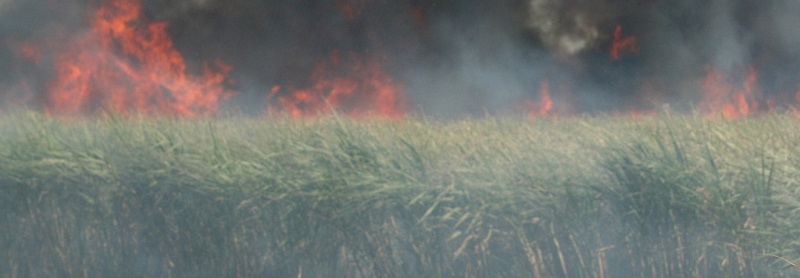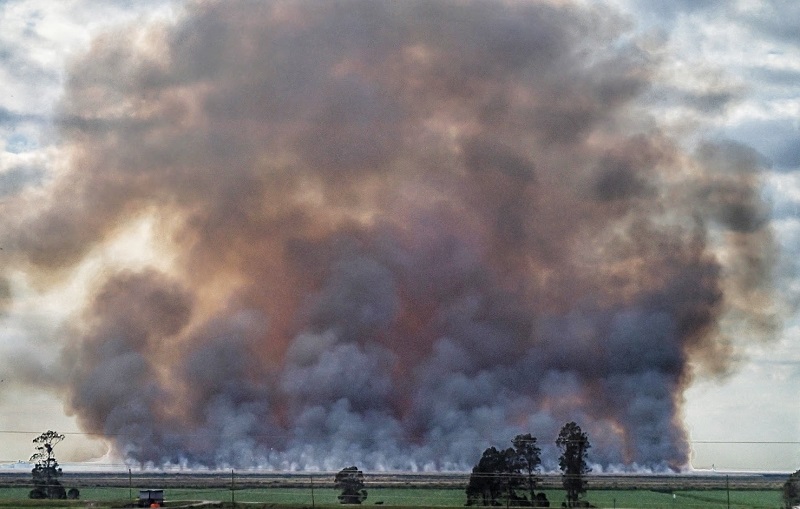Love Thy Neighbor: Florida’s Fight to Stop Sugarcane Burning
Love Thy Neighbor: Florida’s Fight to Stop Sugarcane Burning
You shall love thy neighbor as thyself (Matthew 22.39).
Thick smoke looms over the Glades most months of the year. In these communities south of Florida’s Lake Okeechobee, ash falls on houses and cars, the children call it black snow. Schools have a protocol for when the plumes reach down into town, calling kids inside, closing windows, pulling shades. They still talk about the day when students from Rosenwald Elementary School went to the hospital for smoke inhalation.

Almost half-a-million acres of sugarcane are burned for harvest every year in the fields around the Glades. When the sugarcane industry is your neighbor, the smoke is part of everyday life. So is asthma.
To people who grew up in the Glades, the smoke and the ash and the health issues are all normal, but Shanique Scott knew it wasn’t. Her family traveled around the country. She’d been to Europe and the Caribbean. The smokey air in her hometown was like no place else, not even in the Palm Beach County towns a few miles east.
Scott grew up in her grandmother’s faith and her grandmother’s house, where caring for neighbors in need was part of life. It still is. The number of her family members, friends, and neighbors with cancer diagnoses and asthma keeps climbing. Scott knew studies around the world had already linked cancer risk and exposure to sugarcane burning, and she never stops wondering how much living downwind contributed to all the cases she’s seen.
She moved back home after college to try to make things better for the community that raised her. She ran for office, becoming South Bay’s youngest-ever city commissioner and then mayor. She also taught dance and was struck by how many of her students had respiratory conditions, and how chronic bronchitis outbreaks and sinus problems coincided with burning season. She realized, too, that her sense of smell wasn’t right in burning season. The scented candles she likes are almost undetectable then. But it all comes back when the harvest ends, or whenever she leaves town.
Doctors all over the region know the issue well enough to ask the parents of asthmatic children how close they live to the sugarcane fields. Their private advice to families of sick kids: Move away from the burning.
For most, that’s impossible advice. Even those who could afford it don’t want to leave their homes and families and friends. And why shouldn’t their neighbors, the sugarcane companies, be the ones to make changes? Isn’t there a way to harvest sugarcane without burning the leaves off the stalks first?

There is. It’s called green harvest. Largely because of the air quality and medical problems associated with burning, it’s the law in Brazil, the world’s largest sugarcane producer. It’s been done in Florida, too, documented in a 2015 study by the University of Florida Institute of Food and Agricultural Sciences.
Industry spokespeople say green harvest threatens jobs in the Glades, although harvesting is done by machines today. Still, the threat to eliminate jobs in communities where unemployment rates are among Florida’s highest has kept politicians from pushing for changes–but that threat might be emptier than the companies acknowledge. Information on how many local residents are employed full-time by sugarcane companies is closely guarded, as well as the numbers of part-time and seasonal jobs that go to area residents.
Even when sugarcane was cut by hand, starting back in the 1940s, the work wasn’t done by locals. The companies petitioned the federal government to allow seasonal workers from the Caribbean to bring in the harvest, claiming there wasn’t enough skilled labor in the Glades to fill the jobs. As recently as 1997 sugarcane was cut by imported labor through federal H-2/H2A visa programs.
The companies’ treatment of those workers was no secret. Edward R. Murrow’s 1960 documentary, “Harvest of Shame” made a national issue out of conditions that local communities had known about for years. US Sugar, one of Florida’s two primary sugarcane producers, has the distinction of being the last corporation in US history to face federal slavery charges in the 1940s. The other, Florida Crystals, was investigated by the US Department of Labor in 2013 over accusations of slave trafficking and human rights violations in its Dominican Republic operations.
The industry faced lawsuits into the 2000s for underpaying foreign workers, although those jobs were mostly gone by then, finally replaced in 1998 by mechanized harvesting. A 2018 visit by Bullsugar.org volunteers confirmed that the companies still import labor instead of hiring locally: Buses now take workers to their jobs from temporary housing at the Glades Work Camp in Belle Glade. As long as there are people from elsewhere willing to work for less than area residents can afford to, the legacy of hiring outside the community goes on.
So even if shifting away from pre-harvest burning means higher costs for the sugarcane companies, it’s unclear whether they employ any area residents whose jobs would be affected by the transition. In fact advocates are hopeful that green harvest and any additional labor it requires might mean more job opportunities for Glades communities.
Industry spokespeople also claim that the relatively low number of formal complaints lodged by residents means that sugarcane burning isn’t a serious problem. But there’s a reason for that.
It’s common knowledge that anyone who complains about smoke will be investigated…by the sugar companies. Scott knows. When she called the Florida Forestry Service/Everglades District last February to report smoke drifting into town, the dispatcher took her contact information and promised follow-up.
That follow-up came hours later on the same day, direct from a sugar company employee who had all of Scott’s contact information and details about her complaint. Scott wasn’t surprised, although FFS officials claimed to be when she reported the incident. Agency officials assured her that the violation of privacy was a one-time misunderstanding. It didn’t feel that way to her.
People from communities to the east aren’t so reluctant to complain, though. Smoke drifting toward the coast once threatened to turn into a conflict with Palm Beach County’s more privileged residents, but to them, the industry has become a better neighbor.
When the winds blow from the west, the companies voluntarily postpone burning sugarcane to protect the downwind residents in those communities. Scott wants to know why that protection doesn’t apply to everyone. Why aren’t all sugarcane neighbors equal?
“It’s criminal that the State of Florida and the sugar companies ignore medical research linking sugarcane burning to cancer, respiratory disease, heart disease, and poor infant health,” Scott says. “It’s unconscionable that the people of the Glades are left to suffer the consequences of six-to-eight months of burning while sugar producers in other places have moved to green harvest out of concern for human health.”
Scott and the other green harvest advocates aren’t asking for much. Sugarcane companies are thriving in places where the industry invested in modernization, and that’s exactly what supporters want for Florida’s sugarcane growers: A healthy business that hires locally, runs safely and efficiently, and turns a profit.
What they really hope, ultimately, is that the sugarcane companies whose shadow they’ve lived in all their lives will finally take this one, great step toward becoming a better neighbor. As Scott says, “We just want to show you that sugarcane burning is a problem for us. We’re asking for your help, because this is making us sick.”



